Digital Business Report: Evaluating Asos's Digital Business Strategies
VerifiedAdded on 2023/01/03
|17
|4809
|82
Report
AI Summary
This report provides a comprehensive analysis of Asos, a leading online retailer, as a case study in digital business. It begins with an executive summary and introduction, then explores the trends, advantages, and disadvantages of managing a virtual business in a global environment, and the importance of technology. The report compares and contrasts situation and SWOT analyses, performing a situation analysis for Asos focusing on personalization. It critically evaluates emerging digital business models, addresses information security threats and ethical considerations, and assesses the significance of new collaborative relationships and strategic alliances enabled by digital technology. Finally, it compares and contrasts digital business with e-commerce, outlining e-commerce principles and their application to digital business, concluding with a summary of findings.
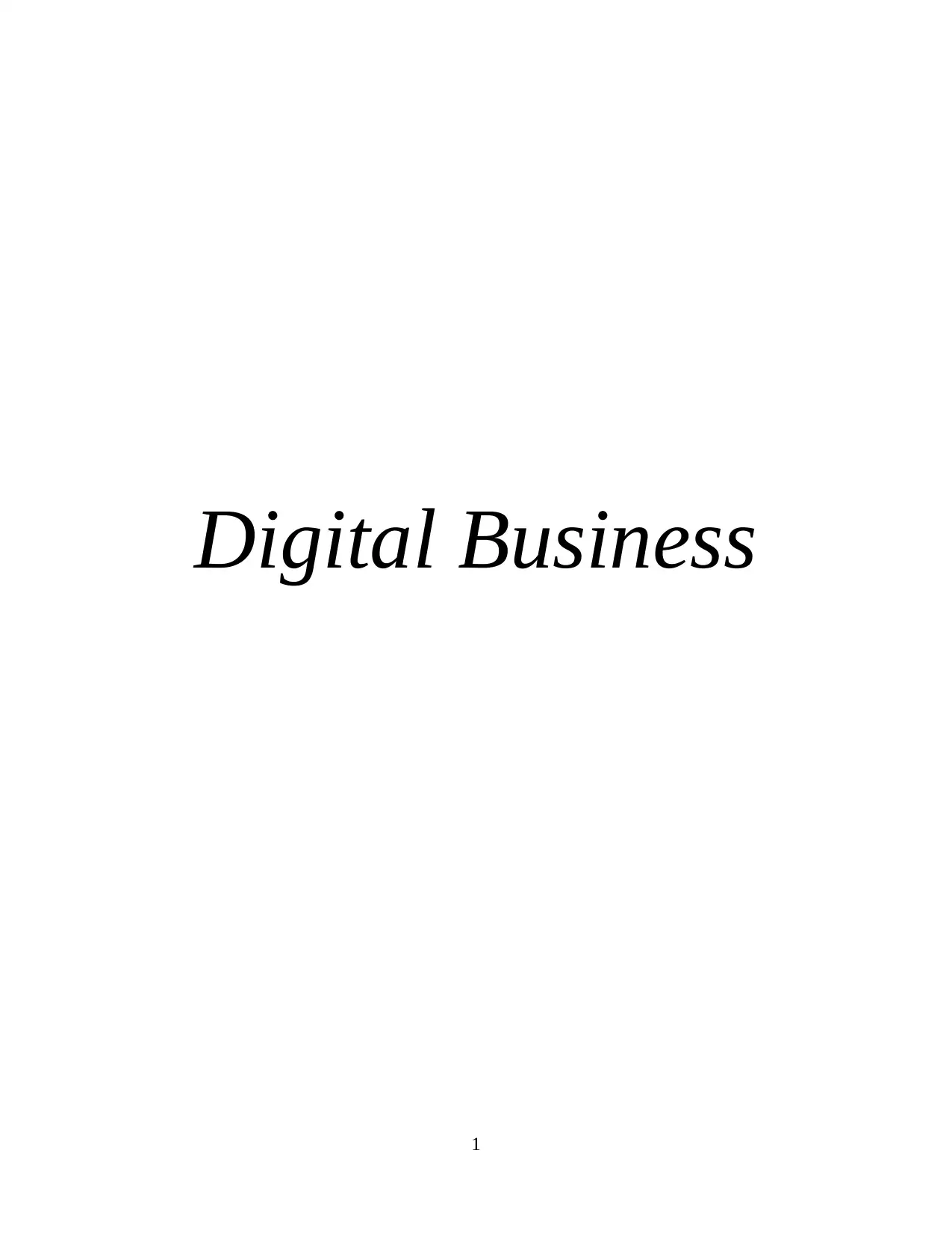
Digital Business
1
1
Paraphrase This Document
Need a fresh take? Get an instant paraphrase of this document with our AI Paraphraser
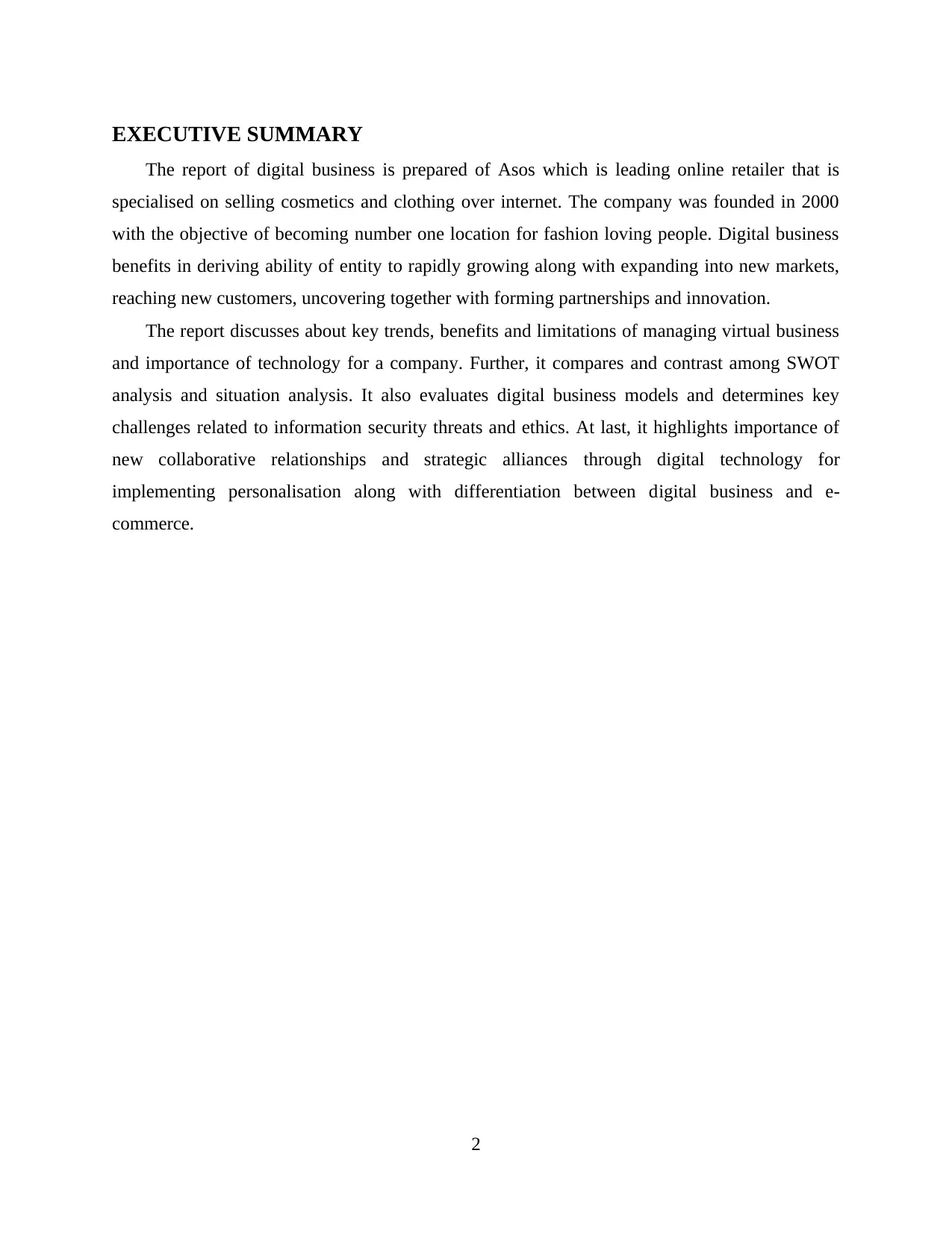
EXECUTIVE SUMMARY
The report of digital business is prepared of Asos which is leading online retailer that is
specialised on selling cosmetics and clothing over internet. The company was founded in 2000
with the objective of becoming number one location for fashion loving people. Digital business
benefits in deriving ability of entity to rapidly growing along with expanding into new markets,
reaching new customers, uncovering together with forming partnerships and innovation.
The report discusses about key trends, benefits and limitations of managing virtual business
and importance of technology for a company. Further, it compares and contrast among SWOT
analysis and situation analysis. It also evaluates digital business models and determines key
challenges related to information security threats and ethics. At last, it highlights importance of
new collaborative relationships and strategic alliances through digital technology for
implementing personalisation along with differentiation between digital business and e-
commerce.
2
The report of digital business is prepared of Asos which is leading online retailer that is
specialised on selling cosmetics and clothing over internet. The company was founded in 2000
with the objective of becoming number one location for fashion loving people. Digital business
benefits in deriving ability of entity to rapidly growing along with expanding into new markets,
reaching new customers, uncovering together with forming partnerships and innovation.
The report discusses about key trends, benefits and limitations of managing virtual business
and importance of technology for a company. Further, it compares and contrast among SWOT
analysis and situation analysis. It also evaluates digital business models and determines key
challenges related to information security threats and ethics. At last, it highlights importance of
new collaborative relationships and strategic alliances through digital technology for
implementing personalisation along with differentiation between digital business and e-
commerce.
2
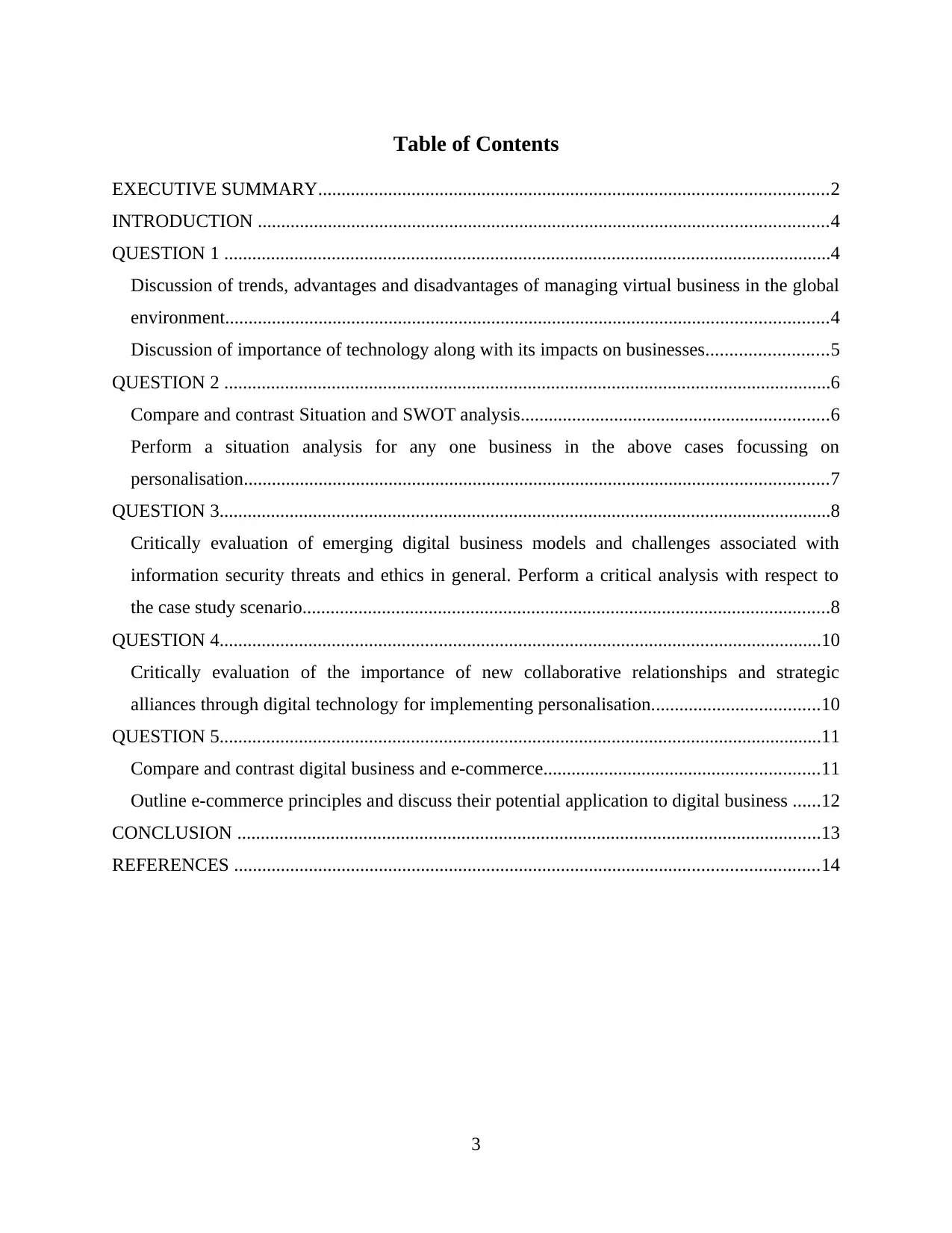
Table of Contents
EXECUTIVE SUMMARY.............................................................................................................2
INTRODUCTION ..........................................................................................................................4
QUESTION 1 ..................................................................................................................................4
Discussion of trends, advantages and disadvantages of managing virtual business in the global
environment.................................................................................................................................4
Discussion of importance of technology along with its impacts on businesses..........................5
QUESTION 2 ..................................................................................................................................6
Compare and contrast Situation and SWOT analysis..................................................................6
Perform a situation analysis for any one business in the above cases focussing on
personalisation.............................................................................................................................7
QUESTION 3...................................................................................................................................8
Critically evaluation of emerging digital business models and challenges associated with
information security threats and ethics in general. Perform a critical analysis with respect to
the case study scenario.................................................................................................................8
QUESTION 4.................................................................................................................................10
Critically evaluation of the importance of new collaborative relationships and strategic
alliances through digital technology for implementing personalisation....................................10
QUESTION 5.................................................................................................................................11
Compare and contrast digital business and e-commerce...........................................................11
Outline e-commerce principles and discuss their potential application to digital business ......12
CONCLUSION .............................................................................................................................13
REFERENCES .............................................................................................................................14
3
EXECUTIVE SUMMARY.............................................................................................................2
INTRODUCTION ..........................................................................................................................4
QUESTION 1 ..................................................................................................................................4
Discussion of trends, advantages and disadvantages of managing virtual business in the global
environment.................................................................................................................................4
Discussion of importance of technology along with its impacts on businesses..........................5
QUESTION 2 ..................................................................................................................................6
Compare and contrast Situation and SWOT analysis..................................................................6
Perform a situation analysis for any one business in the above cases focussing on
personalisation.............................................................................................................................7
QUESTION 3...................................................................................................................................8
Critically evaluation of emerging digital business models and challenges associated with
information security threats and ethics in general. Perform a critical analysis with respect to
the case study scenario.................................................................................................................8
QUESTION 4.................................................................................................................................10
Critically evaluation of the importance of new collaborative relationships and strategic
alliances through digital technology for implementing personalisation....................................10
QUESTION 5.................................................................................................................................11
Compare and contrast digital business and e-commerce...........................................................11
Outline e-commerce principles and discuss their potential application to digital business ......12
CONCLUSION .............................................................................................................................13
REFERENCES .............................................................................................................................14
3
⊘ This is a preview!⊘
Do you want full access?
Subscribe today to unlock all pages.

Trusted by 1+ million students worldwide

4
Paraphrase This Document
Need a fresh take? Get an instant paraphrase of this document with our AI Paraphraser
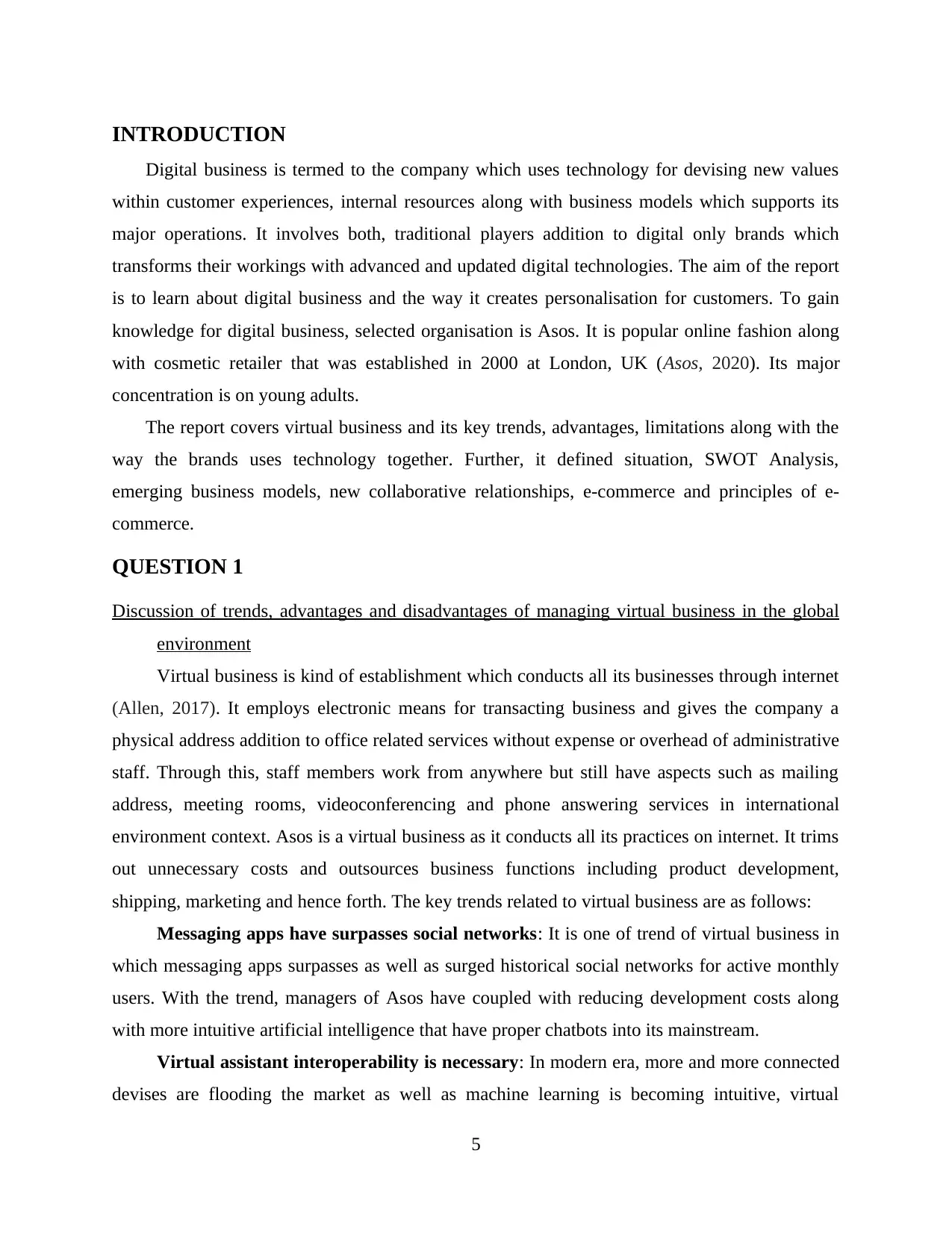
INTRODUCTION
Digital business is termed to the company which uses technology for devising new values
within customer experiences, internal resources along with business models which supports its
major operations. It involves both, traditional players addition to digital only brands which
transforms their workings with advanced and updated digital technologies. The aim of the report
is to learn about digital business and the way it creates personalisation for customers. To gain
knowledge for digital business, selected organisation is Asos. It is popular online fashion along
with cosmetic retailer that was established in 2000 at London, UK (Asos, 2020). Its major
concentration is on young adults.
The report covers virtual business and its key trends, advantages, limitations along with the
way the brands uses technology together. Further, it defined situation, SWOT Analysis,
emerging business models, new collaborative relationships, e-commerce and principles of e-
commerce.
QUESTION 1
Discussion of trends, advantages and disadvantages of managing virtual business in the global
environment
Virtual business is kind of establishment which conducts all its businesses through internet
(Allen, 2017). It employs electronic means for transacting business and gives the company a
physical address addition to office related services without expense or overhead of administrative
staff. Through this, staff members work from anywhere but still have aspects such as mailing
address, meeting rooms, videoconferencing and phone answering services in international
environment context. Asos is a virtual business as it conducts all its practices on internet. It trims
out unnecessary costs and outsources business functions including product development,
shipping, marketing and hence forth. The key trends related to virtual business are as follows:
Messaging apps have surpasses social networks: It is one of trend of virtual business in
which messaging apps surpasses as well as surged historical social networks for active monthly
users. With the trend, managers of Asos have coupled with reducing development costs along
with more intuitive artificial intelligence that have proper chatbots into its mainstream.
Virtual assistant interoperability is necessary: In modern era, more and more connected
devises are flooding the market as well as machine learning is becoming intuitive, virtual
5
Digital business is termed to the company which uses technology for devising new values
within customer experiences, internal resources along with business models which supports its
major operations. It involves both, traditional players addition to digital only brands which
transforms their workings with advanced and updated digital technologies. The aim of the report
is to learn about digital business and the way it creates personalisation for customers. To gain
knowledge for digital business, selected organisation is Asos. It is popular online fashion along
with cosmetic retailer that was established in 2000 at London, UK (Asos, 2020). Its major
concentration is on young adults.
The report covers virtual business and its key trends, advantages, limitations along with the
way the brands uses technology together. Further, it defined situation, SWOT Analysis,
emerging business models, new collaborative relationships, e-commerce and principles of e-
commerce.
QUESTION 1
Discussion of trends, advantages and disadvantages of managing virtual business in the global
environment
Virtual business is kind of establishment which conducts all its businesses through internet
(Allen, 2017). It employs electronic means for transacting business and gives the company a
physical address addition to office related services without expense or overhead of administrative
staff. Through this, staff members work from anywhere but still have aspects such as mailing
address, meeting rooms, videoconferencing and phone answering services in international
environment context. Asos is a virtual business as it conducts all its practices on internet. It trims
out unnecessary costs and outsources business functions including product development,
shipping, marketing and hence forth. The key trends related to virtual business are as follows:
Messaging apps have surpasses social networks: It is one of trend of virtual business in
which messaging apps surpasses as well as surged historical social networks for active monthly
users. With the trend, managers of Asos have coupled with reducing development costs along
with more intuitive artificial intelligence that have proper chatbots into its mainstream.
Virtual assistant interoperability is necessary: In modern era, more and more connected
devises are flooding the market as well as machine learning is becoming intuitive, virtual
5
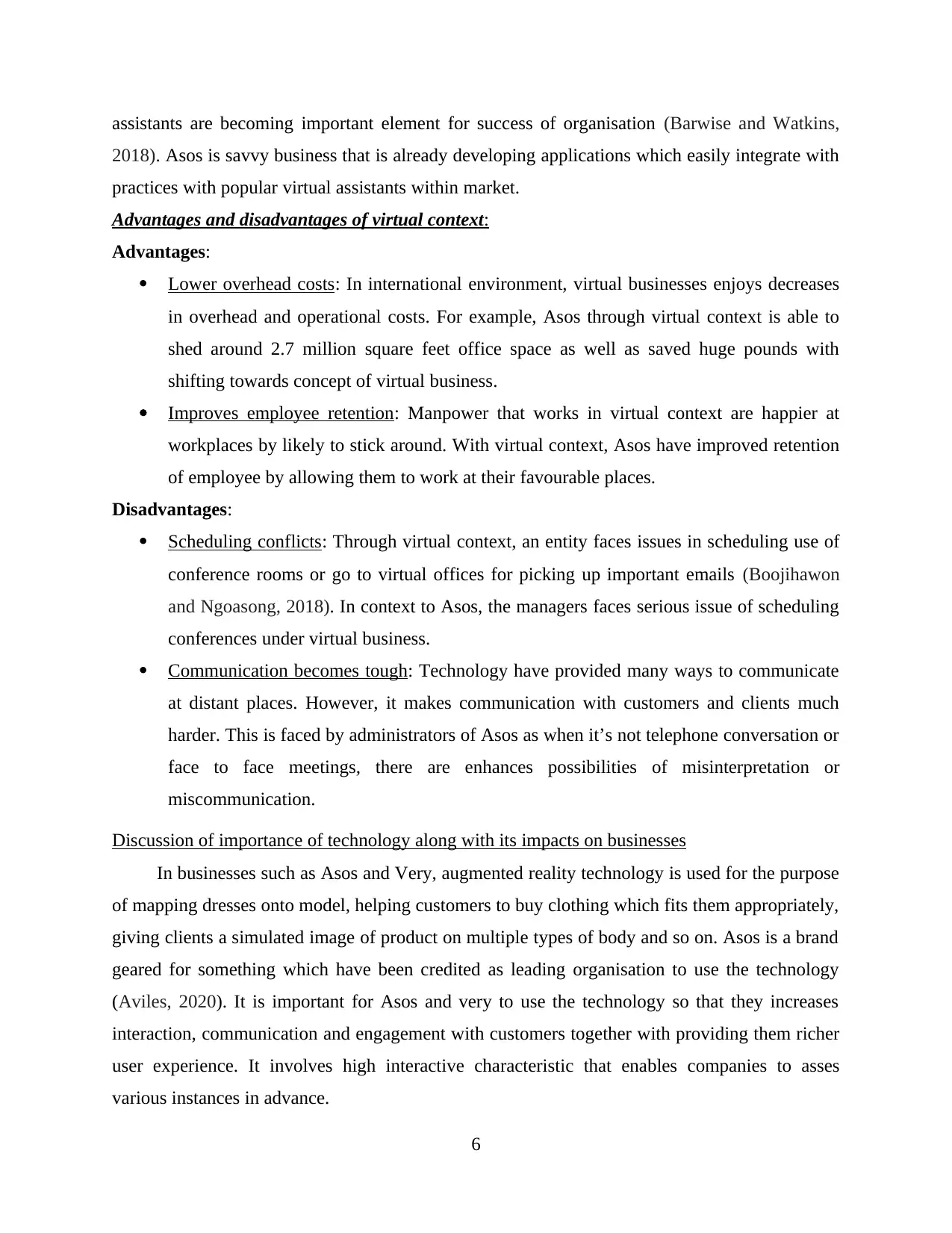
assistants are becoming important element for success of organisation (Barwise and Watkins,
2018). Asos is savvy business that is already developing applications which easily integrate with
practices with popular virtual assistants within market.
Advantages and disadvantages of virtual context:
Advantages:
Lower overhead costs: In international environment, virtual businesses enjoys decreases
in overhead and operational costs. For example, Asos through virtual context is able to
shed around 2.7 million square feet office space as well as saved huge pounds with
shifting towards concept of virtual business.
Improves employee retention: Manpower that works in virtual context are happier at
workplaces by likely to stick around. With virtual context, Asos have improved retention
of employee by allowing them to work at their favourable places.
Disadvantages:
Scheduling conflicts: Through virtual context, an entity faces issues in scheduling use of
conference rooms or go to virtual offices for picking up important emails (Boojihawon
and Ngoasong, 2018). In context to Asos, the managers faces serious issue of scheduling
conferences under virtual business.
Communication becomes tough: Technology have provided many ways to communicate
at distant places. However, it makes communication with customers and clients much
harder. This is faced by administrators of Asos as when it’s not telephone conversation or
face to face meetings, there are enhances possibilities of misinterpretation or
miscommunication.
Discussion of importance of technology along with its impacts on businesses
In businesses such as Asos and Very, augmented reality technology is used for the purpose
of mapping dresses onto model, helping customers to buy clothing which fits them appropriately,
giving clients a simulated image of product on multiple types of body and so on. Asos is a brand
geared for something which have been credited as leading organisation to use the technology
(Aviles, 2020). It is important for Asos and very to use the technology so that they increases
interaction, communication and engagement with customers together with providing them richer
user experience. It involves high interactive characteristic that enables companies to asses
various instances in advance.
6
2018). Asos is savvy business that is already developing applications which easily integrate with
practices with popular virtual assistants within market.
Advantages and disadvantages of virtual context:
Advantages:
Lower overhead costs: In international environment, virtual businesses enjoys decreases
in overhead and operational costs. For example, Asos through virtual context is able to
shed around 2.7 million square feet office space as well as saved huge pounds with
shifting towards concept of virtual business.
Improves employee retention: Manpower that works in virtual context are happier at
workplaces by likely to stick around. With virtual context, Asos have improved retention
of employee by allowing them to work at their favourable places.
Disadvantages:
Scheduling conflicts: Through virtual context, an entity faces issues in scheduling use of
conference rooms or go to virtual offices for picking up important emails (Boojihawon
and Ngoasong, 2018). In context to Asos, the managers faces serious issue of scheduling
conferences under virtual business.
Communication becomes tough: Technology have provided many ways to communicate
at distant places. However, it makes communication with customers and clients much
harder. This is faced by administrators of Asos as when it’s not telephone conversation or
face to face meetings, there are enhances possibilities of misinterpretation or
miscommunication.
Discussion of importance of technology along with its impacts on businesses
In businesses such as Asos and Very, augmented reality technology is used for the purpose
of mapping dresses onto model, helping customers to buy clothing which fits them appropriately,
giving clients a simulated image of product on multiple types of body and so on. Asos is a brand
geared for something which have been credited as leading organisation to use the technology
(Aviles, 2020). It is important for Asos and very to use the technology so that they increases
interaction, communication and engagement with customers together with providing them richer
user experience. It involves high interactive characteristic that enables companies to asses
various instances in advance.
6
⊘ This is a preview!⊘
Do you want full access?
Subscribe today to unlock all pages.

Trusted by 1+ million students worldwide
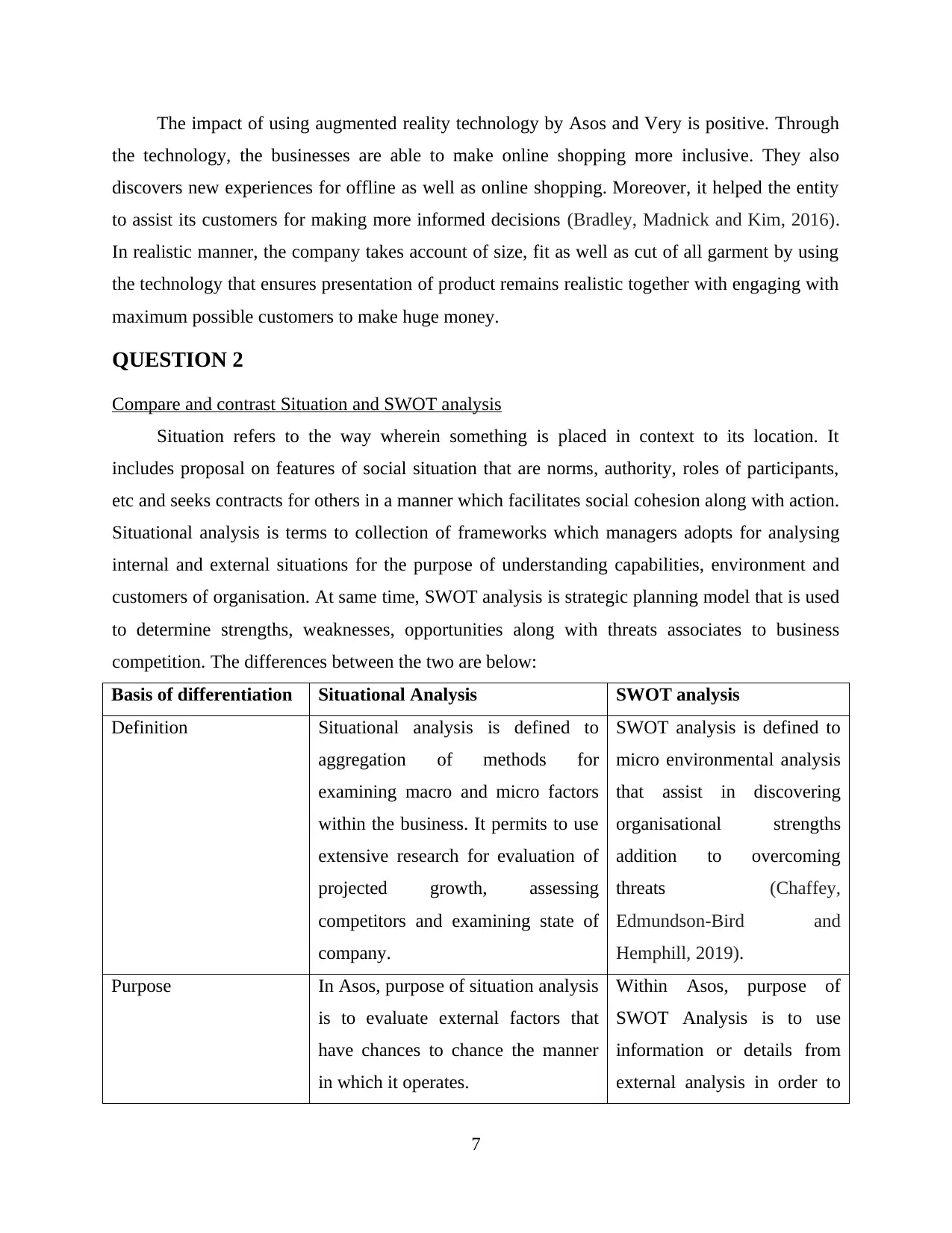
The impact of using augmented reality technology by Asos and Very is positive. Through
the technology, the businesses are able to make online shopping more inclusive. They also
discovers new experiences for offline as well as online shopping. Moreover, it helped the entity
to assist its customers for making more informed decisions (Bradley, Madnick and Kim, 2016).
In realistic manner, the company takes account of size, fit as well as cut of all garment by using
the technology that ensures presentation of product remains realistic together with engaging with
maximum possible customers to make huge money.
QUESTION 2
Compare and contrast Situation and SWOT analysis
Situation refers to the way wherein something is placed in context to its location. It
includes proposal on features of social situation that are norms, authority, roles of participants,
etc and seeks contracts for others in a manner which facilitates social cohesion along with action.
Situational analysis is terms to collection of frameworks which managers adopts for analysing
internal and external situations for the purpose of understanding capabilities, environment and
customers of organisation. At same time, SWOT analysis is strategic planning model that is used
to determine strengths, weaknesses, opportunities along with threats associates to business
competition. The differences between the two are below:
Basis of differentiation Situational Analysis SWOT analysis
Definition Situational analysis is defined to
aggregation of methods for
examining macro and micro factors
within the business. It permits to use
extensive research for evaluation of
projected growth, assessing
competitors and examining state of
company.
SWOT analysis is defined to
micro environmental analysis
that assist in discovering
organisational strengths
addition to overcoming
threats (Chaffey,
Edmundson-Bird and
Hemphill, 2019).
Purpose In Asos, purpose of situation analysis
is to evaluate external factors that
have chances to chance the manner
in which it operates.
Within Asos, purpose of
SWOT Analysis is to use
information or details from
external analysis in order to
7
the technology, the businesses are able to make online shopping more inclusive. They also
discovers new experiences for offline as well as online shopping. Moreover, it helped the entity
to assist its customers for making more informed decisions (Bradley, Madnick and Kim, 2016).
In realistic manner, the company takes account of size, fit as well as cut of all garment by using
the technology that ensures presentation of product remains realistic together with engaging with
maximum possible customers to make huge money.
QUESTION 2
Compare and contrast Situation and SWOT analysis
Situation refers to the way wherein something is placed in context to its location. It
includes proposal on features of social situation that are norms, authority, roles of participants,
etc and seeks contracts for others in a manner which facilitates social cohesion along with action.
Situational analysis is terms to collection of frameworks which managers adopts for analysing
internal and external situations for the purpose of understanding capabilities, environment and
customers of organisation. At same time, SWOT analysis is strategic planning model that is used
to determine strengths, weaknesses, opportunities along with threats associates to business
competition. The differences between the two are below:
Basis of differentiation Situational Analysis SWOT analysis
Definition Situational analysis is defined to
aggregation of methods for
examining macro and micro factors
within the business. It permits to use
extensive research for evaluation of
projected growth, assessing
competitors and examining state of
company.
SWOT analysis is defined to
micro environmental analysis
that assist in discovering
organisational strengths
addition to overcoming
threats (Chaffey,
Edmundson-Bird and
Hemphill, 2019).
Purpose In Asos, purpose of situation analysis
is to evaluate external factors that
have chances to chance the manner
in which it operates.
Within Asos, purpose of
SWOT Analysis is to use
information or details from
external analysis in order to
7
Paraphrase This Document
Need a fresh take? Get an instant paraphrase of this document with our AI Paraphraser
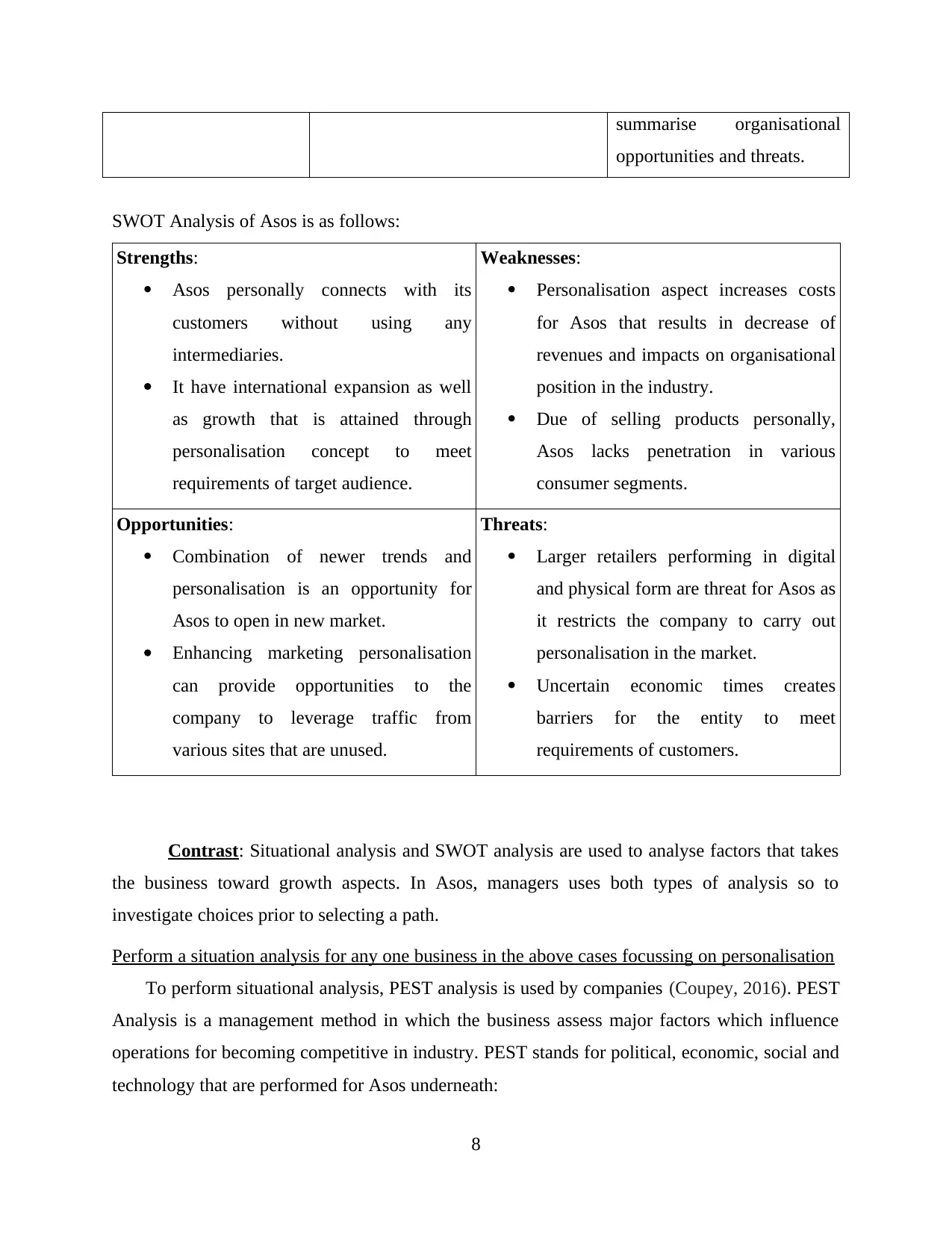
summarise organisational
opportunities and threats.
SWOT Analysis of Asos is as follows:
Strengths:
Asos personally connects with its
customers without using any
intermediaries.
It have international expansion as well
as growth that is attained through
personalisation concept to meet
requirements of target audience.
Weaknesses:
Personalisation aspect increases costs
for Asos that results in decrease of
revenues and impacts on organisational
position in the industry.
Due of selling products personally,
Asos lacks penetration in various
consumer segments.
Opportunities:
Combination of newer trends and
personalisation is an opportunity for
Asos to open in new market.
Enhancing marketing personalisation
can provide opportunities to the
company to leverage traffic from
various sites that are unused.
Threats:
Larger retailers performing in digital
and physical form are threat for Asos as
it restricts the company to carry out
personalisation in the market.
Uncertain economic times creates
barriers for the entity to meet
requirements of customers.
Contrast: Situational analysis and SWOT analysis are used to analyse factors that takes
the business toward growth aspects. In Asos, managers uses both types of analysis so to
investigate choices prior to selecting a path.
Perform a situation analysis for any one business in the above cases focussing on personalisation
To perform situational analysis, PEST analysis is used by companies (Coupey, 2016). PEST
Analysis is a management method in which the business assess major factors which influence
operations for becoming competitive in industry. PEST stands for political, economic, social and
technology that are performed for Asos underneath:
8
opportunities and threats.
SWOT Analysis of Asos is as follows:
Strengths:
Asos personally connects with its
customers without using any
intermediaries.
It have international expansion as well
as growth that is attained through
personalisation concept to meet
requirements of target audience.
Weaknesses:
Personalisation aspect increases costs
for Asos that results in decrease of
revenues and impacts on organisational
position in the industry.
Due of selling products personally,
Asos lacks penetration in various
consumer segments.
Opportunities:
Combination of newer trends and
personalisation is an opportunity for
Asos to open in new market.
Enhancing marketing personalisation
can provide opportunities to the
company to leverage traffic from
various sites that are unused.
Threats:
Larger retailers performing in digital
and physical form are threat for Asos as
it restricts the company to carry out
personalisation in the market.
Uncertain economic times creates
barriers for the entity to meet
requirements of customers.
Contrast: Situational analysis and SWOT analysis are used to analyse factors that takes
the business toward growth aspects. In Asos, managers uses both types of analysis so to
investigate choices prior to selecting a path.
Perform a situation analysis for any one business in the above cases focussing on personalisation
To perform situational analysis, PEST analysis is used by companies (Coupey, 2016). PEST
Analysis is a management method in which the business assess major factors which influence
operations for becoming competitive in industry. PEST stands for political, economic, social and
technology that are performed for Asos underneath:
8
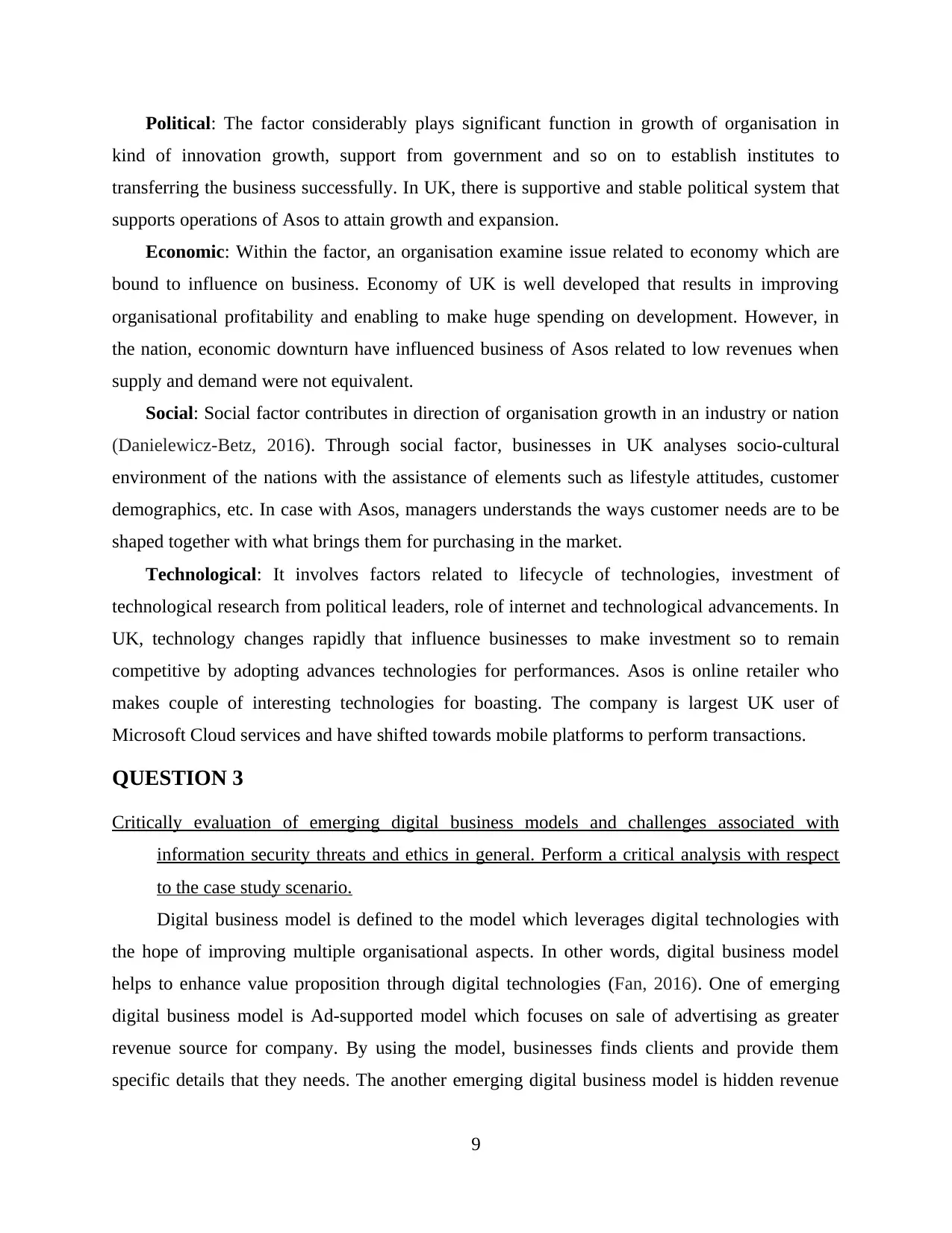
Political: The factor considerably plays significant function in growth of organisation in
kind of innovation growth, support from government and so on to establish institutes to
transferring the business successfully. In UK, there is supportive and stable political system that
supports operations of Asos to attain growth and expansion.
Economic: Within the factor, an organisation examine issue related to economy which are
bound to influence on business. Economy of UK is well developed that results in improving
organisational profitability and enabling to make huge spending on development. However, in
the nation, economic downturn have influenced business of Asos related to low revenues when
supply and demand were not equivalent.
Social: Social factor contributes in direction of organisation growth in an industry or nation
(Danielewicz-Betz, 2016). Through social factor, businesses in UK analyses socio-cultural
environment of the nations with the assistance of elements such as lifestyle attitudes, customer
demographics, etc. In case with Asos, managers understands the ways customer needs are to be
shaped together with what brings them for purchasing in the market.
Technological: It involves factors related to lifecycle of technologies, investment of
technological research from political leaders, role of internet and technological advancements. In
UK, technology changes rapidly that influence businesses to make investment so to remain
competitive by adopting advances technologies for performances. Asos is online retailer who
makes couple of interesting technologies for boasting. The company is largest UK user of
Microsoft Cloud services and have shifted towards mobile platforms to perform transactions.
QUESTION 3
Critically evaluation of emerging digital business models and challenges associated with
information security threats and ethics in general. Perform a critical analysis with respect
to the case study scenario.
Digital business model is defined to the model which leverages digital technologies with
the hope of improving multiple organisational aspects. In other words, digital business model
helps to enhance value proposition through digital technologies (Fan, 2016). One of emerging
digital business model is Ad-supported model which focuses on sale of advertising as greater
revenue source for company. By using the model, businesses finds clients and provide them
specific details that they needs. The another emerging digital business model is hidden revenue
9
kind of innovation growth, support from government and so on to establish institutes to
transferring the business successfully. In UK, there is supportive and stable political system that
supports operations of Asos to attain growth and expansion.
Economic: Within the factor, an organisation examine issue related to economy which are
bound to influence on business. Economy of UK is well developed that results in improving
organisational profitability and enabling to make huge spending on development. However, in
the nation, economic downturn have influenced business of Asos related to low revenues when
supply and demand were not equivalent.
Social: Social factor contributes in direction of organisation growth in an industry or nation
(Danielewicz-Betz, 2016). Through social factor, businesses in UK analyses socio-cultural
environment of the nations with the assistance of elements such as lifestyle attitudes, customer
demographics, etc. In case with Asos, managers understands the ways customer needs are to be
shaped together with what brings them for purchasing in the market.
Technological: It involves factors related to lifecycle of technologies, investment of
technological research from political leaders, role of internet and technological advancements. In
UK, technology changes rapidly that influence businesses to make investment so to remain
competitive by adopting advances technologies for performances. Asos is online retailer who
makes couple of interesting technologies for boasting. The company is largest UK user of
Microsoft Cloud services and have shifted towards mobile platforms to perform transactions.
QUESTION 3
Critically evaluation of emerging digital business models and challenges associated with
information security threats and ethics in general. Perform a critical analysis with respect
to the case study scenario.
Digital business model is defined to the model which leverages digital technologies with
the hope of improving multiple organisational aspects. In other words, digital business model
helps to enhance value proposition through digital technologies (Fan, 2016). One of emerging
digital business model is Ad-supported model which focuses on sale of advertising as greater
revenue source for company. By using the model, businesses finds clients and provide them
specific details that they needs. The another emerging digital business model is hidden revenue
9
⊘ This is a preview!⊘
Do you want full access?
Subscribe today to unlock all pages.

Trusted by 1+ million students worldwide
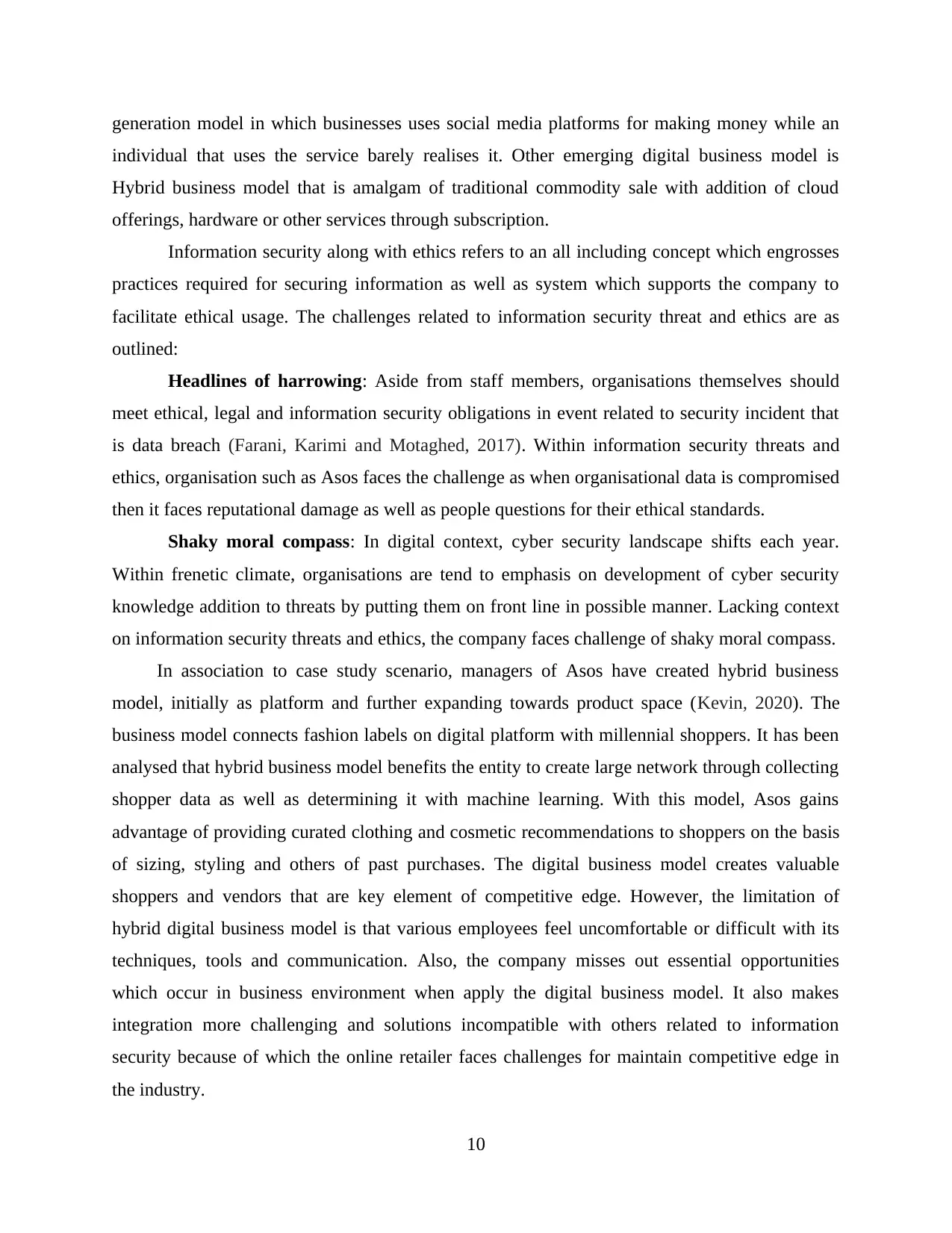
generation model in which businesses uses social media platforms for making money while an
individual that uses the service barely realises it. Other emerging digital business model is
Hybrid business model that is amalgam of traditional commodity sale with addition of cloud
offerings, hardware or other services through subscription.
Information security along with ethics refers to an all including concept which engrosses
practices required for securing information as well as system which supports the company to
facilitate ethical usage. The challenges related to information security threat and ethics are as
outlined:
Headlines of harrowing: Aside from staff members, organisations themselves should
meet ethical, legal and information security obligations in event related to security incident that
is data breach (Farani, Karimi and Motaghed, 2017). Within information security threats and
ethics, organisation such as Asos faces the challenge as when organisational data is compromised
then it faces reputational damage as well as people questions for their ethical standards.
Shaky moral compass: In digital context, cyber security landscape shifts each year.
Within frenetic climate, organisations are tend to emphasis on development of cyber security
knowledge addition to threats by putting them on front line in possible manner. Lacking context
on information security threats and ethics, the company faces challenge of shaky moral compass.
In association to case study scenario, managers of Asos have created hybrid business
model, initially as platform and further expanding towards product space (Kevin, 2020). The
business model connects fashion labels on digital platform with millennial shoppers. It has been
analysed that hybrid business model benefits the entity to create large network through collecting
shopper data as well as determining it with machine learning. With this model, Asos gains
advantage of providing curated clothing and cosmetic recommendations to shoppers on the basis
of sizing, styling and others of past purchases. The digital business model creates valuable
shoppers and vendors that are key element of competitive edge. However, the limitation of
hybrid digital business model is that various employees feel uncomfortable or difficult with its
techniques, tools and communication. Also, the company misses out essential opportunities
which occur in business environment when apply the digital business model. It also makes
integration more challenging and solutions incompatible with others related to information
security because of which the online retailer faces challenges for maintain competitive edge in
the industry.
10
individual that uses the service barely realises it. Other emerging digital business model is
Hybrid business model that is amalgam of traditional commodity sale with addition of cloud
offerings, hardware or other services through subscription.
Information security along with ethics refers to an all including concept which engrosses
practices required for securing information as well as system which supports the company to
facilitate ethical usage. The challenges related to information security threat and ethics are as
outlined:
Headlines of harrowing: Aside from staff members, organisations themselves should
meet ethical, legal and information security obligations in event related to security incident that
is data breach (Farani, Karimi and Motaghed, 2017). Within information security threats and
ethics, organisation such as Asos faces the challenge as when organisational data is compromised
then it faces reputational damage as well as people questions for their ethical standards.
Shaky moral compass: In digital context, cyber security landscape shifts each year.
Within frenetic climate, organisations are tend to emphasis on development of cyber security
knowledge addition to threats by putting them on front line in possible manner. Lacking context
on information security threats and ethics, the company faces challenge of shaky moral compass.
In association to case study scenario, managers of Asos have created hybrid business
model, initially as platform and further expanding towards product space (Kevin, 2020). The
business model connects fashion labels on digital platform with millennial shoppers. It has been
analysed that hybrid business model benefits the entity to create large network through collecting
shopper data as well as determining it with machine learning. With this model, Asos gains
advantage of providing curated clothing and cosmetic recommendations to shoppers on the basis
of sizing, styling and others of past purchases. The digital business model creates valuable
shoppers and vendors that are key element of competitive edge. However, the limitation of
hybrid digital business model is that various employees feel uncomfortable or difficult with its
techniques, tools and communication. Also, the company misses out essential opportunities
which occur in business environment when apply the digital business model. It also makes
integration more challenging and solutions incompatible with others related to information
security because of which the online retailer faces challenges for maintain competitive edge in
the industry.
10
Paraphrase This Document
Need a fresh take? Get an instant paraphrase of this document with our AI Paraphraser
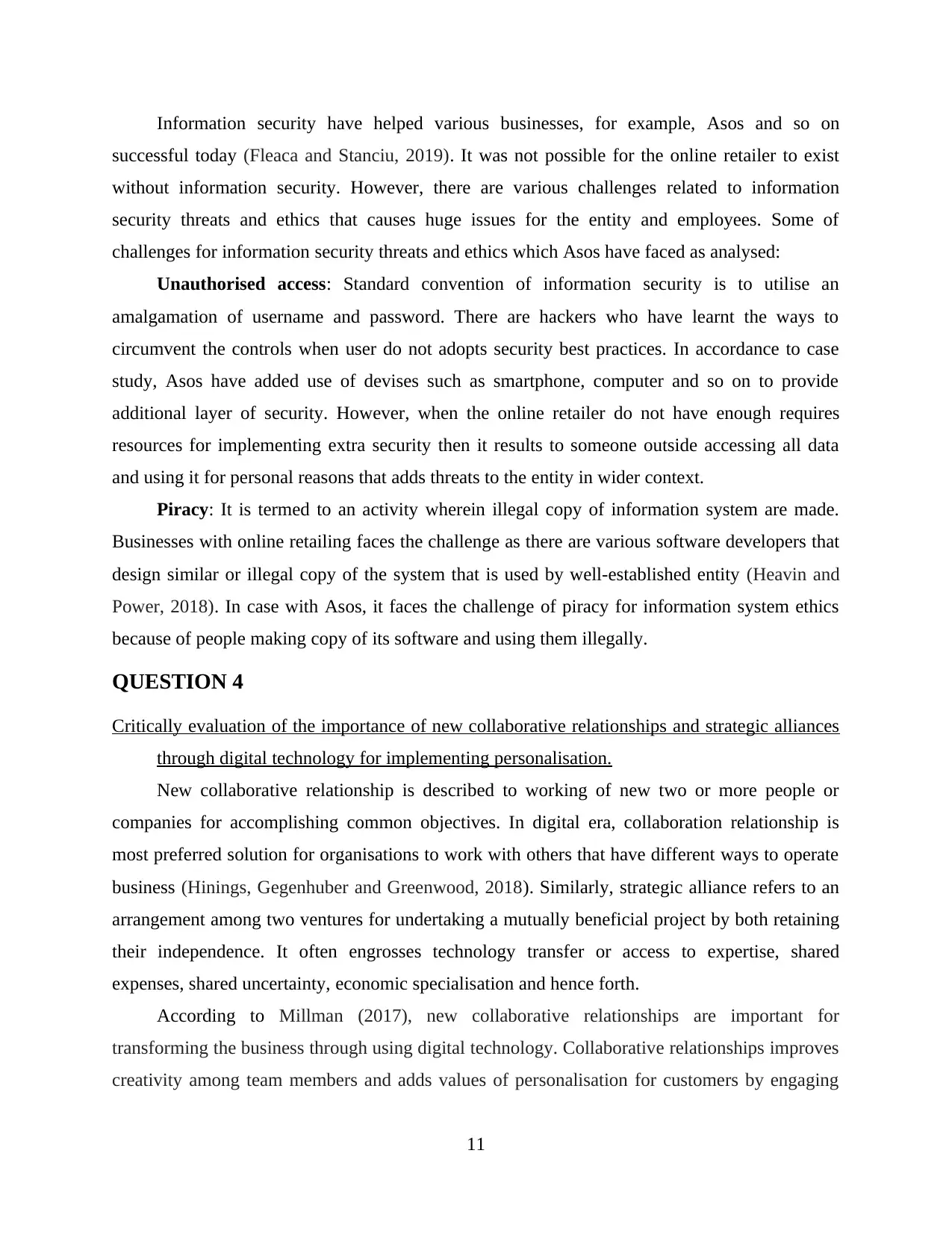
Information security have helped various businesses, for example, Asos and so on
successful today (Fleaca and Stanciu, 2019). It was not possible for the online retailer to exist
without information security. However, there are various challenges related to information
security threats and ethics that causes huge issues for the entity and employees. Some of
challenges for information security threats and ethics which Asos have faced as analysed:
Unauthorised access: Standard convention of information security is to utilise an
amalgamation of username and password. There are hackers who have learnt the ways to
circumvent the controls when user do not adopts security best practices. In accordance to case
study, Asos have added use of devises such as smartphone, computer and so on to provide
additional layer of security. However, when the online retailer do not have enough requires
resources for implementing extra security then it results to someone outside accessing all data
and using it for personal reasons that adds threats to the entity in wider context.
Piracy: It is termed to an activity wherein illegal copy of information system are made.
Businesses with online retailing faces the challenge as there are various software developers that
design similar or illegal copy of the system that is used by well-established entity (Heavin and
Power, 2018). In case with Asos, it faces the challenge of piracy for information system ethics
because of people making copy of its software and using them illegally.
QUESTION 4
Critically evaluation of the importance of new collaborative relationships and strategic alliances
through digital technology for implementing personalisation.
New collaborative relationship is described to working of new two or more people or
companies for accomplishing common objectives. In digital era, collaboration relationship is
most preferred solution for organisations to work with others that have different ways to operate
business (Hinings, Gegenhuber and Greenwood, 2018). Similarly, strategic alliance refers to an
arrangement among two ventures for undertaking a mutually beneficial project by both retaining
their independence. It often engrosses technology transfer or access to expertise, shared
expenses, shared uncertainty, economic specialisation and hence forth.
According to Millman (2017), new collaborative relationships are important for
transforming the business through using digital technology. Collaborative relationships improves
creativity among team members and adds values of personalisation for customers by engaging
11
successful today (Fleaca and Stanciu, 2019). It was not possible for the online retailer to exist
without information security. However, there are various challenges related to information
security threats and ethics that causes huge issues for the entity and employees. Some of
challenges for information security threats and ethics which Asos have faced as analysed:
Unauthorised access: Standard convention of information security is to utilise an
amalgamation of username and password. There are hackers who have learnt the ways to
circumvent the controls when user do not adopts security best practices. In accordance to case
study, Asos have added use of devises such as smartphone, computer and so on to provide
additional layer of security. However, when the online retailer do not have enough requires
resources for implementing extra security then it results to someone outside accessing all data
and using it for personal reasons that adds threats to the entity in wider context.
Piracy: It is termed to an activity wherein illegal copy of information system are made.
Businesses with online retailing faces the challenge as there are various software developers that
design similar or illegal copy of the system that is used by well-established entity (Heavin and
Power, 2018). In case with Asos, it faces the challenge of piracy for information system ethics
because of people making copy of its software and using them illegally.
QUESTION 4
Critically evaluation of the importance of new collaborative relationships and strategic alliances
through digital technology for implementing personalisation.
New collaborative relationship is described to working of new two or more people or
companies for accomplishing common objectives. In digital era, collaboration relationship is
most preferred solution for organisations to work with others that have different ways to operate
business (Hinings, Gegenhuber and Greenwood, 2018). Similarly, strategic alliance refers to an
arrangement among two ventures for undertaking a mutually beneficial project by both retaining
their independence. It often engrosses technology transfer or access to expertise, shared
expenses, shared uncertainty, economic specialisation and hence forth.
According to Millman (2017), new collaborative relationships are important for
transforming the business through using digital technology. Collaborative relationships improves
creativity among team members and adds values of personalisation for customers by engaging
11
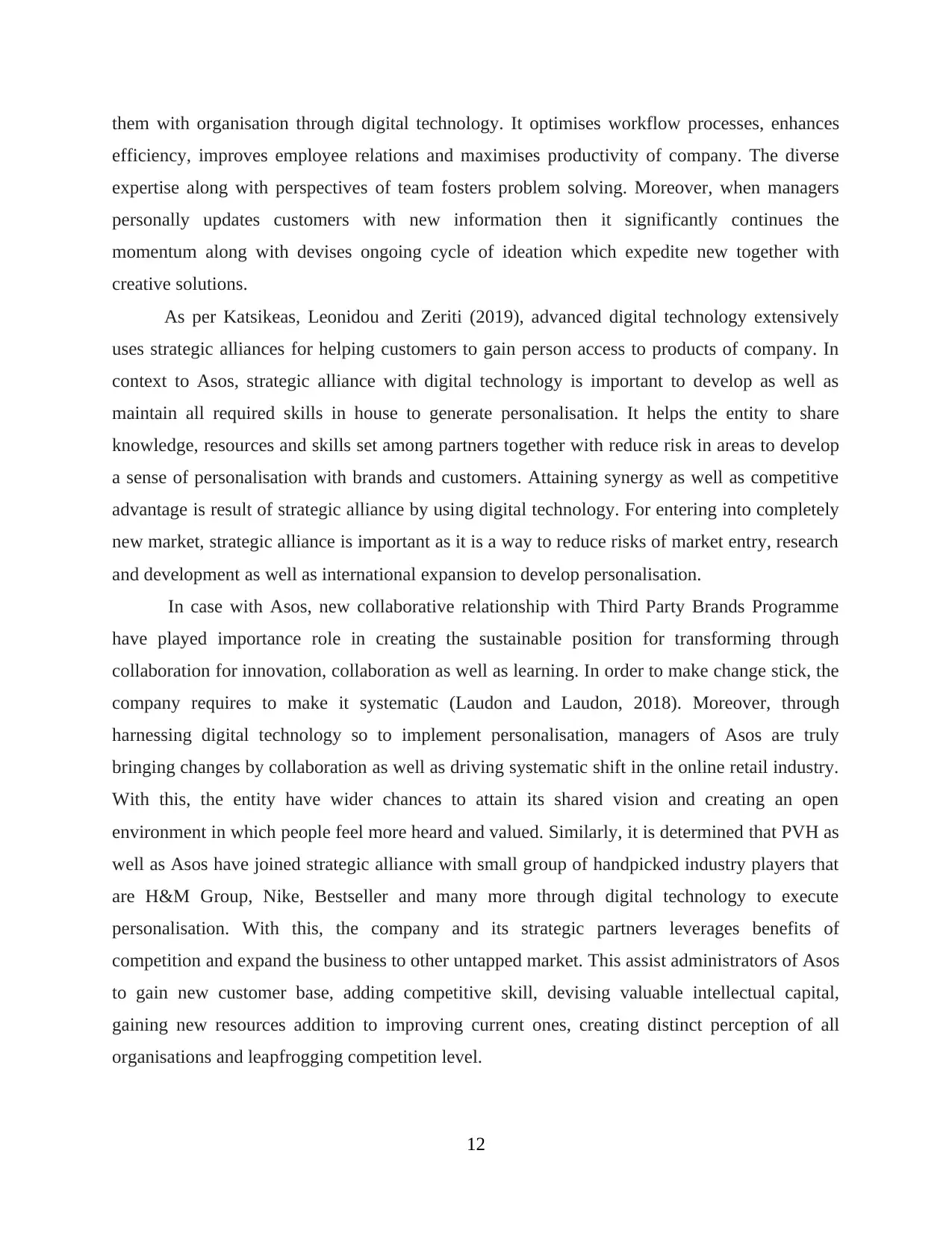
them with organisation through digital technology. It optimises workflow processes, enhances
efficiency, improves employee relations and maximises productivity of company. The diverse
expertise along with perspectives of team fosters problem solving. Moreover, when managers
personally updates customers with new information then it significantly continues the
momentum along with devises ongoing cycle of ideation which expedite new together with
creative solutions.
As per Katsikeas, Leonidou and Zeriti (2019), advanced digital technology extensively
uses strategic alliances for helping customers to gain person access to products of company. In
context to Asos, strategic alliance with digital technology is important to develop as well as
maintain all required skills in house to generate personalisation. It helps the entity to share
knowledge, resources and skills set among partners together with reduce risk in areas to develop
a sense of personalisation with brands and customers. Attaining synergy as well as competitive
advantage is result of strategic alliance by using digital technology. For entering into completely
new market, strategic alliance is important as it is a way to reduce risks of market entry, research
and development as well as international expansion to develop personalisation.
In case with Asos, new collaborative relationship with Third Party Brands Programme
have played importance role in creating the sustainable position for transforming through
collaboration for innovation, collaboration as well as learning. In order to make change stick, the
company requires to make it systematic (Laudon and Laudon, 2018). Moreover, through
harnessing digital technology so to implement personalisation, managers of Asos are truly
bringing changes by collaboration as well as driving systematic shift in the online retail industry.
With this, the entity have wider chances to attain its shared vision and creating an open
environment in which people feel more heard and valued. Similarly, it is determined that PVH as
well as Asos have joined strategic alliance with small group of handpicked industry players that
are H&M Group, Nike, Bestseller and many more through digital technology to execute
personalisation. With this, the company and its strategic partners leverages benefits of
competition and expand the business to other untapped market. This assist administrators of Asos
to gain new customer base, adding competitive skill, devising valuable intellectual capital,
gaining new resources addition to improving current ones, creating distinct perception of all
organisations and leapfrogging competition level.
12
efficiency, improves employee relations and maximises productivity of company. The diverse
expertise along with perspectives of team fosters problem solving. Moreover, when managers
personally updates customers with new information then it significantly continues the
momentum along with devises ongoing cycle of ideation which expedite new together with
creative solutions.
As per Katsikeas, Leonidou and Zeriti (2019), advanced digital technology extensively
uses strategic alliances for helping customers to gain person access to products of company. In
context to Asos, strategic alliance with digital technology is important to develop as well as
maintain all required skills in house to generate personalisation. It helps the entity to share
knowledge, resources and skills set among partners together with reduce risk in areas to develop
a sense of personalisation with brands and customers. Attaining synergy as well as competitive
advantage is result of strategic alliance by using digital technology. For entering into completely
new market, strategic alliance is important as it is a way to reduce risks of market entry, research
and development as well as international expansion to develop personalisation.
In case with Asos, new collaborative relationship with Third Party Brands Programme
have played importance role in creating the sustainable position for transforming through
collaboration for innovation, collaboration as well as learning. In order to make change stick, the
company requires to make it systematic (Laudon and Laudon, 2018). Moreover, through
harnessing digital technology so to implement personalisation, managers of Asos are truly
bringing changes by collaboration as well as driving systematic shift in the online retail industry.
With this, the entity have wider chances to attain its shared vision and creating an open
environment in which people feel more heard and valued. Similarly, it is determined that PVH as
well as Asos have joined strategic alliance with small group of handpicked industry players that
are H&M Group, Nike, Bestseller and many more through digital technology to execute
personalisation. With this, the company and its strategic partners leverages benefits of
competition and expand the business to other untapped market. This assist administrators of Asos
to gain new customer base, adding competitive skill, devising valuable intellectual capital,
gaining new resources addition to improving current ones, creating distinct perception of all
organisations and leapfrogging competition level.
12
⊘ This is a preview!⊘
Do you want full access?
Subscribe today to unlock all pages.

Trusted by 1+ million students worldwide
1 out of 17
Related Documents
Your All-in-One AI-Powered Toolkit for Academic Success.
+13062052269
info@desklib.com
Available 24*7 on WhatsApp / Email
![[object Object]](/_next/static/media/star-bottom.7253800d.svg)
Unlock your academic potential
Copyright © 2020–2025 A2Z Services. All Rights Reserved. Developed and managed by ZUCOL.





